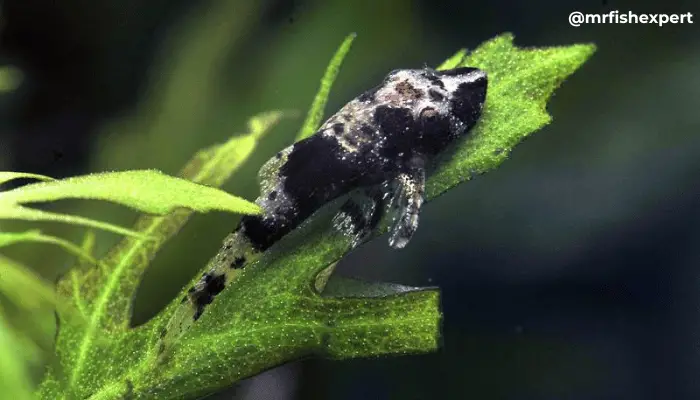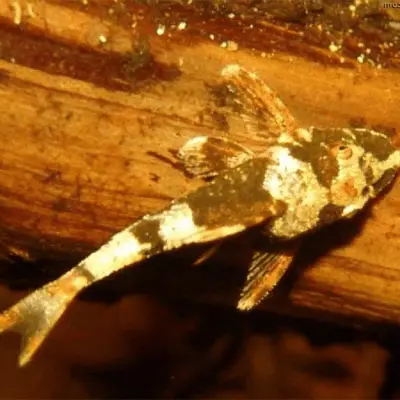Bumblebee otocinclus is a type of otocinclus catfish also known as Rhinotocinclus Isabelae. The Otocinclus was used for reducing the algae growth in the fish tank. Otocinclus will eat green algae and reduce the spreading of algae.
Otocinclus was suitable for most fish tanks because they are peaceful fish. But Otocinclus needs proper care for a long lifespan. Sudden changes in the water parameters and aggressive tankmates will make them stressed and affect their health.
The Bumblebee otocinclus was similar to the common otocinclus but its appearance is different like the Bumblebee’s color and Rhino’s appearance on the body. In this article, you’ll learn more about Bumblebee otocinclus and the care guide.
What is Bumblebee Otocinclus fish?

| Fish Information | |
| Common Name | Bumblebee Otocinclus |
| Scientific Name | Rhinotocinclus isabelae |
| Family | Loricariidae |
| Locality | Western part of the Amazon Rainforest |
Appearance
Bumblebee otocinclus appearance is similar to common otocinclus. The color and rhino design on the body make them unique from other otocinclus fishes. The yellow and brown color with rhinoceros faces with large dorsal fins.
Water parameters
Below are the required water parameters for bumblebee Otocinclus.
| Parameter | Value |
| Temperature | 72°F to 78°F (22°C to 26°C) |
| pH Level | 6.5 to 7.5 |
| Water Hardness (GH) | 5 to 12 dGH |
| Ammonia | 0 ppm |
| Nitrite | 0 ppm |
| Nitrate | Below 20-30 ppm |
Lifespan
Normally Otocinclus have a short lifespan of 3 to 7 years with proper care. Basically, they are freshwater fish found in rivers, and shifting them into fish tanks will shorten their lifespan. Otocinclus needs proper care and water conditioned fish tank for a longer lifespan or else the fish will die faster within a few months.
In order to make otocinclus healthy, You need to keep a good filtration system in the fish and weekly tank maintenance. Heater and live plants are important for otocinclus fish. The heater will increase the water temperature and stabilize according to requirements.
Temperament
Bumblebee Otocinclus was a low temperament fish suitable for most fish tanks with peaceful fishes. Don’t keep otocinclus with high-temperament fish or aggressive fishes because they will attack otocinclus and lead to major health problems and body damage.
You need to provide a hiding place for otocinclus and live plants. Otocinclus spends more time on the leaves of the plants or on the glass for eating algae. Don’t keep them alone because otocinclus loves to live in groups.
Common Disease
- Ich (Ichthyophthirius multifiliis): It was a common disease found in aquarium fishes. The white spot on the body parts of bumblebee otocinclus such as fins, gills, and skins. It was a common parasitic infection that affected every fish. You can treat Otocinclus for Ich by raising the water temperature and adding aquarium salt. You need to separate the otocinclus into another tank for treatment.
- Fungal Infections: Fungal infection affects the skin and the fin part of the otocinclus fish. Especially if they have injuries on the body parts. You can identify the fish behavior and white cotton growth on the body parts. You can treat otocinclus with antifungal medication.
- Bacterial Infections: The Otocinclus have bacterial infections due to poor water quality. Symptoms may include red sores, fin rot, or pop-eye. For treatment of bacterial infection, you can use antibiotics prescribed by a vet. Cleaning the water and maintaining water quality will improve the health condition and immunity system.
Diet

Bumblebee otocinclus is a herbivorous fish and they eat algae, vegetables, algae wafers, and other supplements to improve their health condition. High-quality algae wafers are used for feeding herbivorous fish such as plecos, otocinclus, etc. You can feed a few quantities of algae wafers every two days and don’t overfeed.
Not only algae wafers you can feed them vegetables such as cucumber and zucchini. Live and frozen food can be given to otocinclus only once a week. If you overfeed the otocinclus then algae will start spreading in the tank and lead to major health problems for all fish.
Habitat
Otocinclus are mainly found in river basins and they are native to South America. Otocinclus likes to live in slow-moving water or still water such as rivers and small streams. They need clean water with medium oxygen content and rocks or other substrates.
Tankmates
Bumblebee otocinclus is a peaceful fish suitable for low-aggression fish tanks. Below is the list of tankmates suitable for otocinclus.
- Neon Tetras
- Ember Tetras
- Cardinal Tetras
- Corydoras Catfish
- Bronze Corydoras
- Panda Corydoras
- Rasboras
- Chili Rasboras
- Harlequin Rasboras
- Dwarf Gouramis
- Endler’s Livebearers
- Guppies
- Kuhli Loaches
- Cherry Shrimp
- Amano Shrimp
- Nerite Snails
- Mystery Snails
- Apistogramma
- Bolivian Ram
- Bristlenose Plecos
- Hillstream Loaches
Care guide
Otocinclus required proper care and quality water. To maintain quality water in the tank you need to install a proper filtration system and weekly water maintenance. Heater and live plants are important for otocinclus fish tanks because sudden changes in the water parameters will affect the health and immunity system of the fish.
You need to keep bumblebee otocinclus with peaceful tankmates and provide quality algae wafers and vegetables. Monitor the otocinclus every day and analyze the health and behavior of the fish.
If they have any health problems then you need to separate the fish to another tank and treat them with a vet prescription.
Breeding
Breeding bumblebee otocinclus is a hard task for beginners. You can breed otocinclus after experiences and maintaining water quality and water parameters are important for otocinclus breeding.
You need to use a separate tank for breeding otocinclus and set up and filter and heater for controlling the water temperature. Use the small filter for the breeding tank because a high flow rate filter will impact the outer shell of the eggs. For more details about the breeding otocinclus, You can read our detailed breeding guide.
What Plants Do Otocinclus likes
Otocinclus are herbivorous fish and they like to stay on the plants and eat small bacteria. Below is the list of plants that otocinclus likes.
- Java Moss (Taxiphyllum barbieri)
- Anubias (Anubias spp.)
- Java Fern (Microsorum pteropus)
- Hornwort (Ceratophyllum demersum)
- Vallisneria (Vallisneria spp.)
- Duckweed (Lemna minor)
- Guppy Grass (Najas guadalupensis)
- Water Sprite (Ceratopteris thalictroides)
- Amazon Sword (Echinodorus spp.)
- Marimo Moss Balls (Aegagropila linnaei)
What is the Price of bumblebee Otocinclus?
The average price of Bumblebee otocinclus is $11.99 and it can vary according to the size and appearance of the fish.
How many bumblebee otocinclus should be kept together?
You should keep at least 6 bumblebee otocinclus in a fish tank. If you have a lot of space then you can keep 10 to 20 otocinclus in a single tank.
Why bumblebee otocinclus have a short lifespan?
The average lifespan of otocinclus is 3 to 7 years with proper care. However sudden changes in the water quality and water parameters will shorten the lifespan of otocinclus fish. There are a lot of other factors that affect the lifespan of otocinclus such as breeding pairs, tankmates, low-quality feeds, and common health problems.
